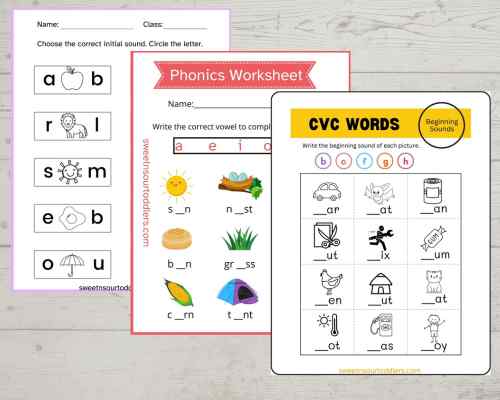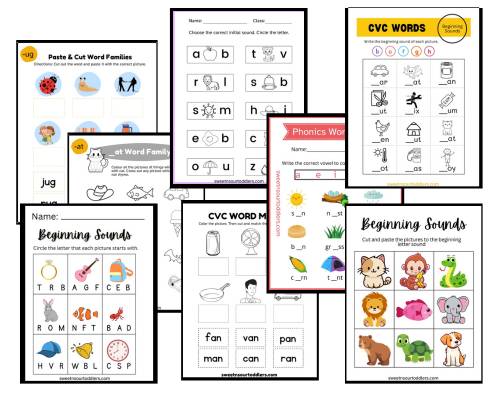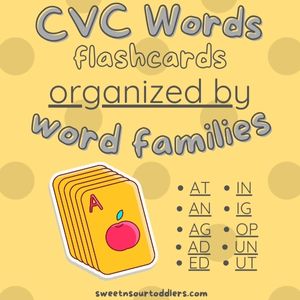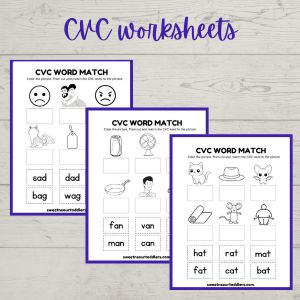
Are you trying to teach your child how to read?
It’s important to know that there is an ORDER to teach reading. I taught my child to teach by the age of 2.5 (you can read more about that here) and I have some super helpful tips to share with you along with TONS of free phonics worksheets and activity pages.
Get your free printables at the end of this post!
1. Pre-Reading Skills
First off you have pre-reading skills. These are the skills your child should master before you begin teaching how to read. You can read more in this post here on pre-reading skills.
Once your child has a strong pre-reading foundation, you can move on to phonics.
Phonics is the foundation stone of teaching kids how to read.
2. What is Phonics?
Phonics is a method of teaching reading by correlating sounds with symbols in an alphabetic writing system. It focuses on the relationship between letters and their sounds, enabling children to decode words as they read.
So it’s super important that when you teach your child the letter name you also teach them the letter sound.
Example: this is the letter A and it makes the sound /aaaaaa/
I’ve created some super fun phonics activity sheets that your child will love doing! Download your free printables at the end of this post!
3. Understanding Phonemic Awareness
Phonemic awareness is the ability to hear, identify, and manipulate individual sounds (phonemes) in spoken words.
This skill is a crucial precursor to reading and writing, as it lays the foundation for understanding the sound structure of language.
The goal is for your child to understand that each word we say is made up of individual sounds. Being able to hear, identify and manipulate these sounds is called phonemic awareness.
Please note that phonemic awareness is different from phonics. While the former is purely auditory, the latter involves print.
Playing games and doing fun activities is the best way to develop strong phonemic awareness skills. Reading rhyming books to your child, playing blending games and doing activities that involve understanding the beginning and ending sounds of words are great places to start!
Lucky for you, I have some awesome phonemic awareness worksheets that you can download for free at the end of this post!
This page contains affiliate links. If you choose to purchase after clicking a link, I may receive a commission at no extra cost to you.
4. CVC Words and Blending
CVC words are three-letter words following the consonant-vowel-consonant pattern, such as “cat,” “dog,” and “pig.” These words are fundamental in early reading instruction because they are simple, phonetic, and easy for children to decode and encode.
Blending involves combining individual sounds to form words, which is essential for reading fluency. For example, blending the sounds /c/, /a/, and /t/ forms the word “cat.”
Learning how to blend sounds can vary for each child. Some kids pick it up quickly, while others need a bit more time. However, with consistent practice, any child can master blending.
Keep practicing three-letter words regularly. Once your child gets the hang of blending, reading becomes much easier for them.
To make blending fun for my child, I turned it into a game. Here’s what we did:
I’d write a CVC word, like “CAT,” on one side of a square piece of paper and draw a funny cat on the flip side.
My child would sound out each letter //c// //a// //t// and then say the word “cat.” Afterward, she’d flip the paper to see if she was correct.
Whenever she got a word right, we’d high five and race from her room to the living room.
My child loved this game. With the funny pictures, high fives, and races, she thought it was the coolest game ever. She would always ask to play.
Sometimes I’d pretend to be too tired and say we could only play for a little while. This made her even more eager to play.
Within a few weeks, she was fluently reading three-letter words thanks to this simple, silly game!
I encourage you to find a blending game that your child enjoys.
Lucky for you, I created super cute CVC words with cute pictures which you can download for FREE at the end of this post 🙂
5. Using Word Families to Aid Reading
Word families are groups of words with a common ending, like -at, -et, -it, -ot, and -ut.
Teaching word families helps children recognize patterns in words, making it easier to decode and expand their vocabulary. For instance, learning the -at family (cat, bat, hat, rat) helps children quickly grasp the -et family (bet, get, let, pet).
I have some amazing word family activity sheets that you can download for free at the end of this post!
6. Fun Phonics Activity Sheets
To make learning to read enjoyable and effective, I’ve created a variety of fun phonics activity sheets for my kids which you can download for free.
These worksheets cover key topics such as phonics, phonemic awareness, CVC words, blending, and word families.
These worksheets are designed to be engaging and interactive, helping children practice and reinforce their reading skills in a fun way.
Free Worksheets for Each Topic
- Phonics: Explore our phonics worksheets that help children connect letters to sounds and develop their decoding skills.
- Phonemic Awareness: Our phonemic awareness sheets focus on activities like sound matching, segmenting, and blending to build a strong foundation for reading.
- CVC Words: Practice reading and writing CVC words with our collection of worksheets and flashcards designed to make these simple words fun to read.
- Blending: Use our blending worksheets to help children combine individual sounds into whole words, enhancing their reading fluency.
- Word Families: Discover our word family worksheets that encourage pattern recognition and vocabulary expansion through common word endings.
Get your free download!

Are you trying to teach your child how to read and feel totally clueless?
When my daughter was two and a half, teaching her to read was the last thing on my mind. Like most toddler parents, I was much too preoccupied with challenges like potty training and managing tantrums.
I stumbled upon Children Learning Reading totally by accident.
I watched in jaw drop amazement videos of kids as kids as young as 2 sounding out words and reading full sentences.
I was so honestly so skeptical about trying it out. My first thought was that my child was way too young to start. My second thought was that it would take too much effort and time and I didn’t have either to spare.
I put aside these limiting thoughts and instead thought: what do I have to lose?
And so I started. I spent 10 minutes a day and much to my amazement, within a few weeks of using Children Learning Reading my child was reading 3 letter words! She soon progressed to reading sentences and then little short stories.

I can not begin to describe the joy you feel when you see your little one confidently finish reading a story by themselves from beginning to end!
She’s 5 now, reads at 3rd grade level and I literally need to ask her to come out of her reading corner!
If you’re interested, you can read my detailed post on how I taught my child to read: what are the things that worked for us, what I learned from the whole process of teaching my child to read and what I’d recommend you to do.
Check out Children Learning Reading and see why 70,000 plus parents have used this reading program (with zero teaching experience) to see some incredible results!
We think you’ll enjoy reading these posts next:
10 Super Fun Phonics Activities to Boost Your Child’s Reading Skills
5 Toddler Pre-Reading Skills and How to Inculcate Them
10 Inspiring Ideas For Setting Up An Insanely Cute Toddler Reading Corner
Children Learning Reading Review – An Honest Opinion From a Mom
Understanding and Teaching CVC Words: A Guide for Educators and Parents





Leave a Reply